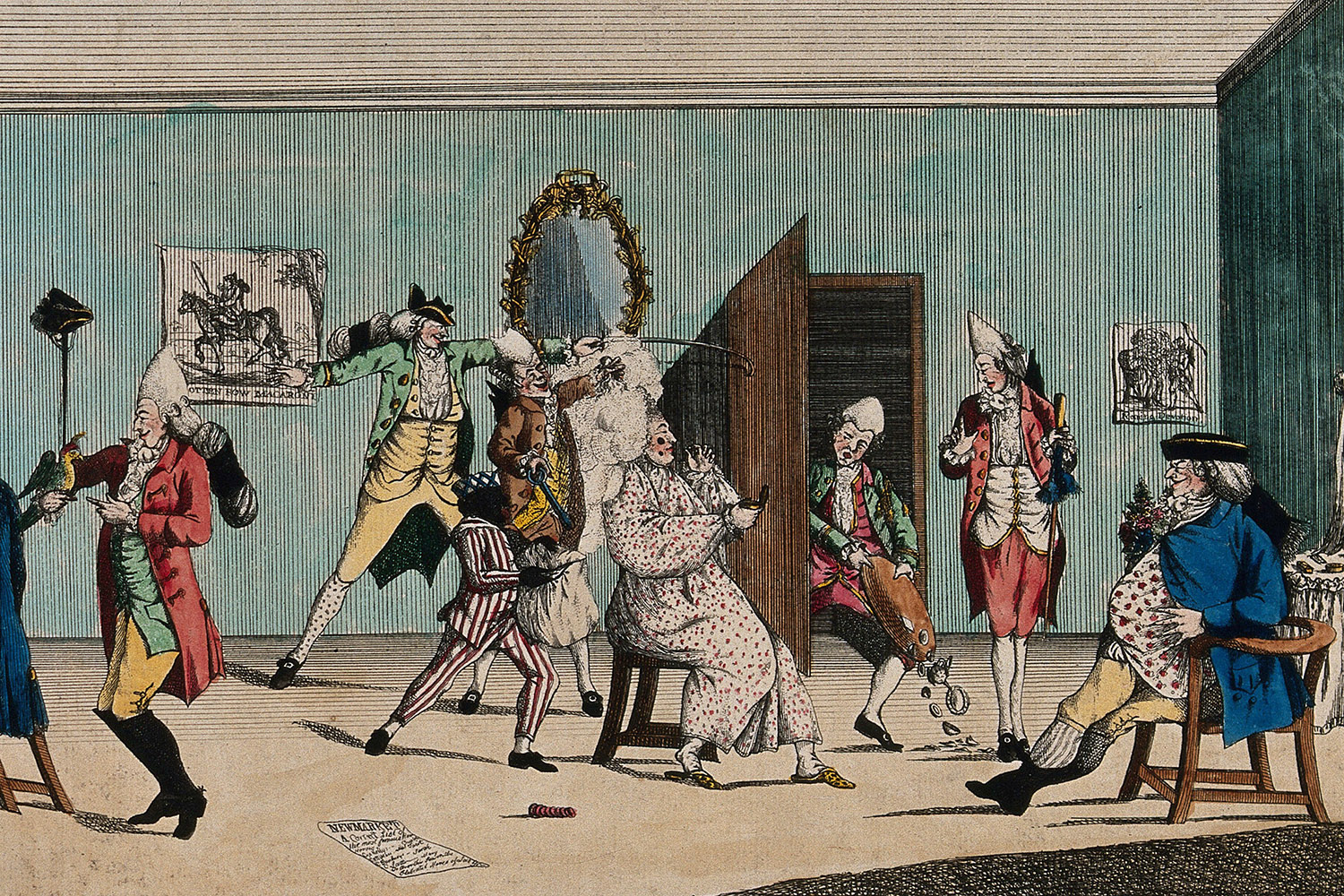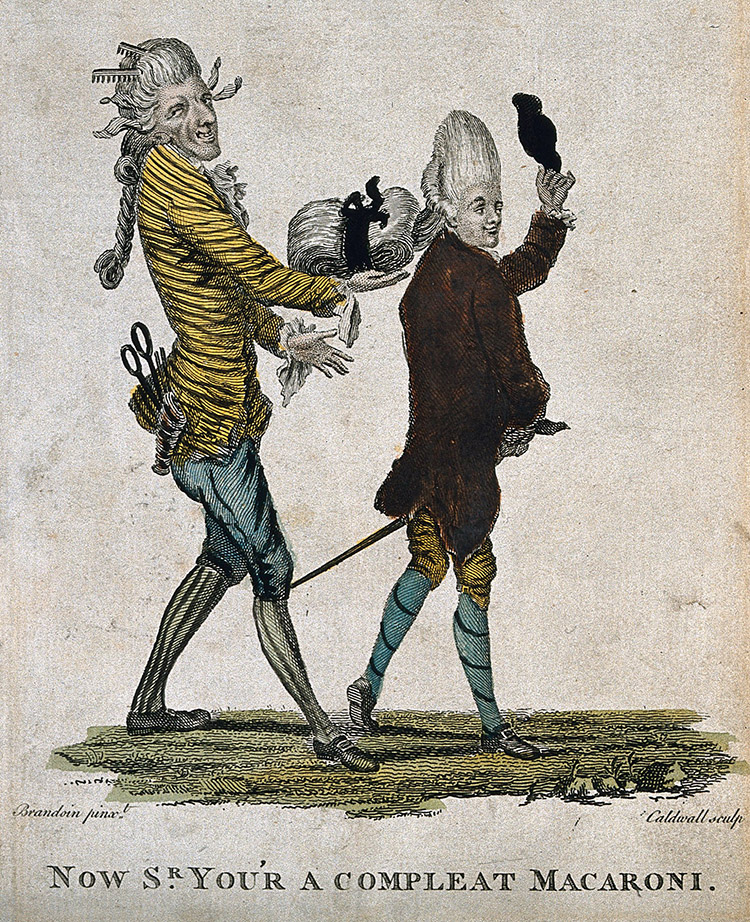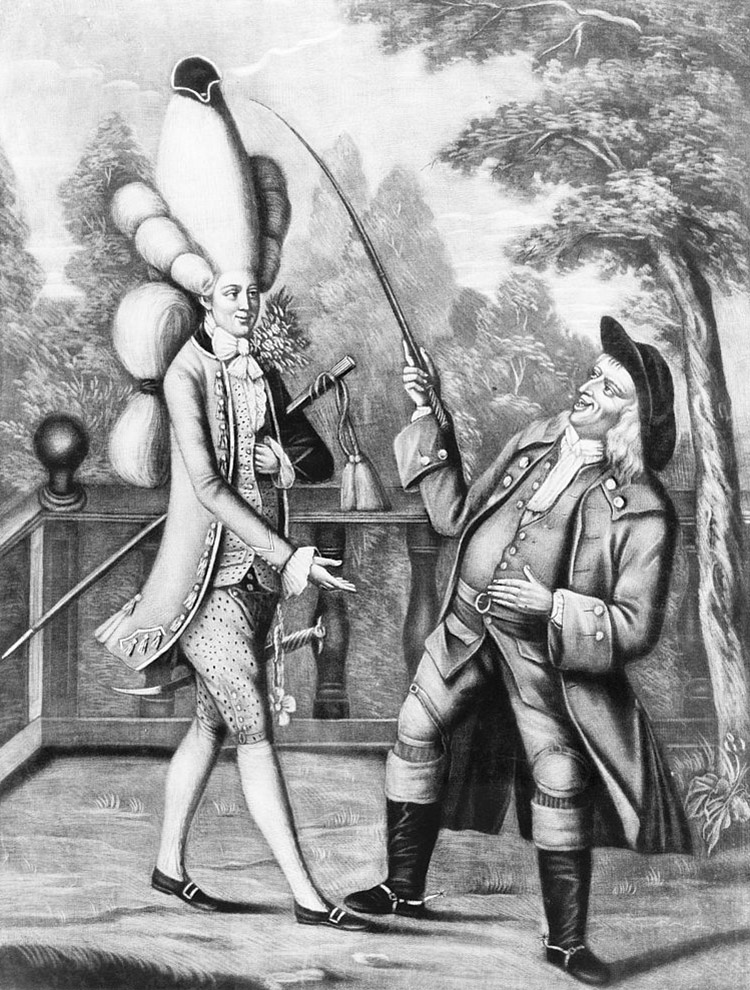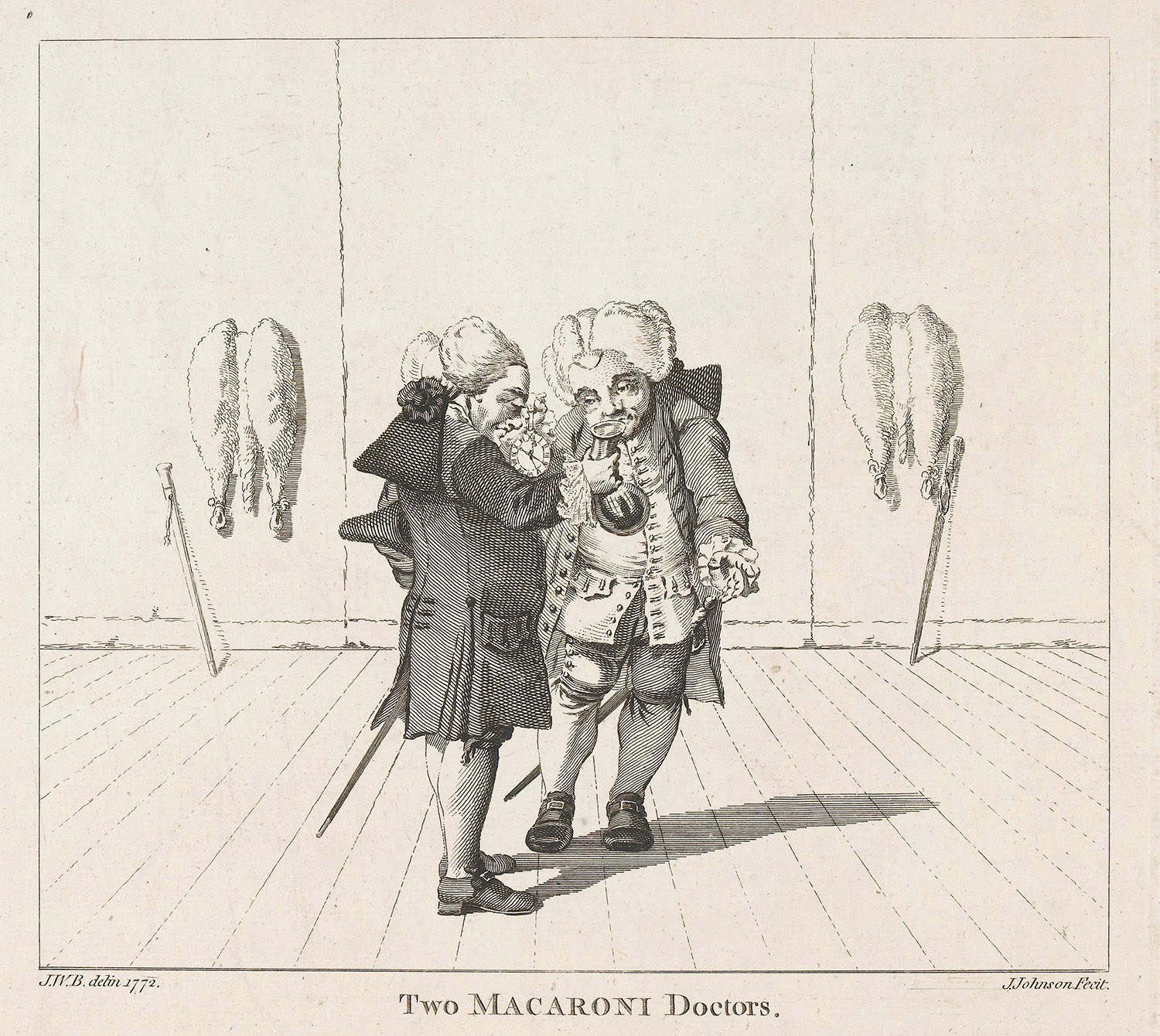Meet the Macaronis
During the 1770s there emerged a new type of fashionable fellow: the Macaroni, whose style was frequently and easily lampooned by cartoonists and the media.

In the last quarter of the 18th century, an age of extravagant fashions, the style of clothing adopted by the macaronis attracted much contemporary comment. These young men affected great sensibility and were famous for their effeminate dress; they were, in fact, the latest in a long line of young men in the 18th century (and before) who, by exaggerating current styles and trends in dress, started new fashions.
Earlier in the century they had been called 'beaux'; a famous example of this kind of fashionable young man is described in Smollett's novel Roderick Random (1748) where Captain Whiffle:
Overshadowed with a vast umbrella ... dressed in this manner; a white hat garnished with a red feather adorned his head from whence his hair flowed upon his shoulders in ringlets tied behind with ribbon. His coat, consisting of a pink-coloured silk lined with white, by the elegance of the cut retired backwards, as it were, to discover a white satin waistcoat embroidered with gold, unbuttoned at the upper part to display a brooch set with garnets that glittered in the breast of his shirt, which was of the finest cambric edged with right Mechlin. The knees of his crimson velvet breeches scarcely descended so low as to meet his silk stockings which rose without a spot or wrinkle on his meagre legs, from shoes of blue Meroquin, studded with diamond buckles that flamed forth rivals to the sun ... But the most remarkable parts of his furniture were, a mask on his face, and white gloves on his hands which did not seem to be put on with an intention to be pulled off occasionally, but were fixed with a curious ring on the little finger of each hand.
Captain Whiffle's name passed immediately into the 18th-century vocabulary as being synonymous with effeminacy; some years later a 'Billy Whiffle' meant a macaroni. His clothing, as described by Smollett, was luxurious and extravagant; the lavish and bright fabrics and jewellery (in a period when men's everyday clothing was beginning to favour darker colours and woollen cloth), the care of the complexion and the replacing of the conventional wig with bag and side curls, with the hair in ringlets all contributed to his startling appearance.

The actual word 'macaroni' does not seem to have appeared until the early 1760s. In 1764 Horace Walpole explained to the Earl of Hertford that the macaronis were a club, 'which is composed of all the travelled young men who wear long curls and spying-glasses'; he attributed their extreme fashions to the wealth brought back from India. The origins of the term were more fully explained in the Town and Country Magazine for March 1772, when the craze was at its height:
The Italians are extremely fond of a dish they call Macaroni, composed of a kind of paste; and, as they consider this as the summum bonum of all good eating, so they figuratively call everything they think elegant and uncommon Macaroni. Our young travellers, who generally catch the follies of the countries they visit, judged that the tide of Macaroni was very applicable to a clever fellow; and accordingly they instituted a club under this denomination, the members of which were supposed to be the standards of taste in polite learning, the fine arts and the genteel sciences; and fashion, amongst the other constituent parts of taste, became an object of their attention. But they soon proved, they had very little claim to any distinction, except in their external appearance.
In fact, some of the original founders of the Macaroni club were keen to encourage the arts by offering medals and prizes for painting, sculpture, music and poetry; but this worthy aim was soon lost sight of in the pursuit of new sartorial fashions.
Throughout the 18th century the snobbery which was an essential part of fashion meant that the fabrics and styles of clothing that were most admired came from abroad and in particular from France and Italy. The bright colours and silken stuffs and the lavish use of lace, all of which characterised the dress of the macaroni, were either imported or imitated; so also was the new narrow cut which in effect turned the coat into a tail coat. By the late 1760s wigs were dressed very high on the head, a feature the macaronis exaggerated by adopting a very small hat called a Nivernois, named after the French Ambassador in London.
William Hickey in 1769 noted the complete transformation of a friend of his after a visit to France:
instead of the plain brown cloth suit we had last seen him in, with unpowdered hair and a single curl, we now beheld a furiously powdered and pomatumed head with six curls on each side, a little skimming dish of a hat ... His coat was of a thick silk, the colour sky blue and lined with crimson satin, the waistcoat and breeches also of crimson satin, coat and waistcoat being bedizened with a tawdry spangled lace. The cut too was entirely different from anything we had seen, having a remarkable long waist to the coat with scarce any skirts.
From 1772-3 macaroni fashions were at their height, led by Charles James Fox and a group of young members of the aristocracy; they belonged to a number of clubs such as the Scavoir-Vivre and Almacks and were avid supporters of Mrs Cornelys' entertainments at Carlisle House and the masquerades at the Pantheon. The macaronis coincided with a great increase in the early 1770s of newspapers and magazines devoted to fashionable as well as political news; the period also sees the beginning of the great age of the caricaturist to whom the macaronis were a godsend.

The Universal Magazine in October 1772 commented on the widespread adoption of macaroni fashions by all professions and classes of society – 'Old England is overrun with Macaroni-parsons, Turf-Macaronis, Macaroni Dancing-masters, and Grub-street Macaronis'; caricatures of these and many more were on sale at the print shops; and some were used to illustrate newspaper articles which made much of the fashion. The Universal Magazine goes on to describe a macaroni:
You may know a Macaroni when you come near him by his essences and scented waters; and if your sense of smelling is not very acute, you may discover him by seeing everything about him most extravagantly outre. His hat, like his understanding, is very little .... He has generally a good quantity of hair- and if he has not ... he borrows it from his neighbours. His coat slouches down behind, and reaches just far enough to cover his hind parts. His breeches are usually very large and roomy ... But his manners are still more strange than his dress. He is the sworn foe of learning ... and yet the creature affects some of the fine arts. He attends at auctions where he picks up the names of painters and vomits them forth on all occasions. He affects a rapturous taste for music and is continually humming in Piano. If you see him at the theatre he will scarce wink without his opera-glasses.
A number of publications capitalised on the macaroni fashions; these included the Macaroni Magazine or Monthly Intelligence of the Fashions and Diversions, the Macaroni, Scavoir-Vivre and Theatrical Magazine and the Macaroni Jester and Pantheon of Wit. None of these magazines lasted for more than a few issues, and all relied on the same heavily sarcastic jokes at the expense of the macaronis ('Yesterday died of a Consumption, occasioned by the Use of Paint, Sir William Whiffle, who has long been deemed the first-rate Macaroni of the Age') with accounts of fashionable amusements such as theatres and masquerades.
One of the more amusing descriptions comes from the Macaroni Jester and purports to be a 'Journal of a Maccaroni':
Rise at Eleven – Survey my sweet Face in the Glass, and pick my Teeth for half an Hour. Breakfast at Twelve – over the Morning Papers. Dressed by Half-past One – to saunter to the Park and stare at the Women, for the Reputation of having a Taste for them. At Three o'Clock saunter into the City, to show myself to the Brutes who are void of taste. Dine at Four – saunter an Hour at the Coffee-House and then to the Play, to talk louder than the Actors. Nine o'Clock – take a Woman of the Town to the Shakespeare; treat her with a Bottle of Champagne, and leave her as I found her. Sup with our own Club at Eleven – drink, swear and invent new Toasts till Three, and then go Home in a Chair to Bed.
Even well-established magazines like the Lady's Magazine increased their sales by articles and stories involving macaronis and their female counterparts, whom Walpole called 'Macaronesses' and who carried to extremes the prevailing fashions, particularly the very high hairstyles and headdresses of the 1770s. In 1773, for example, the Lady's Magazine for January published 'The Macaroni Dialogue, or a Colloquy between Sir Harry Dimple and Lady Betty Frisky', illustrated with an engraving showing these two leaders of fashion discussing their plans to appear at the Pantheon that evening:
Sir Har: I hope I shall have the honour of your ladyship's hand to walk a minuet or turn a cotillon – We shall be two of the most exquisite figures in the whole rotunda ...
Lady Bet: I beg, Sir Harry, that your club maybe increased in proportion to my head, or else we shall not be fit partners.
Sir Har: My lady, I shall have it just as large again, and I propose my toupee shall be heightened three inches.
Lady Bet: You will then be the emperor of the Macaronies.
Sir Har: And your ladyship the empress.
An event in which some macaronis were involved, and which brought them great discredit, was the famous 'Vauxhall affray' of July 1773. While walking in Vauxhall Gardens the actress Mrs Hartley 'was put out of countenance by what she deemed the impudent looks of four or five gentlemen'; her companion Parson Henry Bate (afterwards Sir Henry Bate Dudley) remonstrated with the young men; but one of them, 'a little effeminate being, whom I afterwards found to be a Mr Fitz-Gerall, came up to me, dressed a la Macaroni, and impertinently asked me "whether any man had not a right to look at a fine woman".' After some heated exchanges among which the parson made fun of Fitzgerald – 'the dress, hat and feather, a miniature picture pendant at his snow-white bosom, and a variety of other delicate appendages to this man of fashion, were naturally seized on by me, and set off to the best advantage' – there followed a 'bruising match' in which Bate defeated a supposed Captain Miles, a servant of Fitzgerald. The newspapers were full of this affair and of the humiliation of the macaronis, and Bate was said to have acquired the name of the Fighting Parson.

Like all such fashions, the macaroni craze could not be prolonged indefinitely and some months after the Vauxhall affray Walpole remarked on their disappearance from the fashionable scene: 'Even the Maccaronis degenerate; they have lost all their money and credit and ruin nobody but their tailors' (February 1774). By 1776, according to Fanny Burney, even the word was was no longer the 'ton'.
One of the main reasons for the decline of the macaroni in high society was, of course, the fact that the fashion was taken up by the City, and even by the lower classes as it worked its way down. In its exaggerated form it excited contempt; in the comedy The Macaroni, performed in 1773 at the theatre in the Haymarket, the main character Epicene, whom we see being dressed by his French valet, complains that it is impossible to introduce Italian fashions in England because of the hostility they aroused.
Yet by exaggerating the trends towards a slender figure as typified by the narrow cut coat, the macaronis were merely in advance of the fashion uniformly adopted by the outbreak of the French Revolution. Modern men, in addition, might be grateful for the innovation (in pursuit of an unbroken narrow line) of the inside pocket introduced by the macaronis and firmly established by the late 1770s.
The macaronis provided entertainment to their contemporaries for a decade, and to the social historian a revealing side line on the vagaries of fashion.
This article was originally published in the July 1978 issue of History Today with the title 'The Macaronis'.




